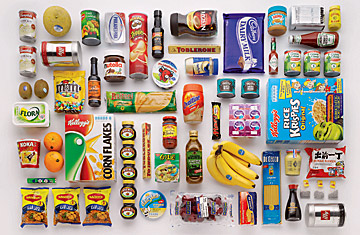
C.L.R James, the great Trinidadian essayist, once wrote of his favorite sport, "What do they know of cricket, who only cricket know?" The same question should be asked of food. To write about food only as food misses the point, or the many points, about the great universal human experience between birth and death. Food is not just what we eat. It charts the ebbs and flows of economies, reflects the changing patterns of trade and geopolitical alliances, and defines our values, status and health—for better and worse. The famous dictum of the early 19th century French gastronome Jean Anthelme Brillat-Savarin, "Tell me what you eat and I will tell you who you are," should be expanded. Tell me what you eat and I will tell you who you are, where you live, where you stand on political issues, who your neighbors are, how your economy functions, your country's history and foreign relations, and the state of the environment. By looking at food, the age we live in is better understood.
Once, food was defined by a very small geographic zone, prescribed by the products and traditions in that area. Where there were wars, food was modified. Arabs conquered Europe; cane sugar went with them. The Chinese entered Japan and the soybean entered the Japanese diet. Immigration left a mark, too. Jews fleeing Portugal brought chocolate to southwestern France. African slaves brought frying and okra to the Caribbean and the American South. It seemed every time a royal marriage was arranged in France, the cuisine gained a few ingredients and dishes. Modern historians question the influence of Catherine de' Medici when she arrived in Paris in 1533 at the age of 14, with an extensive Italian cooking staff. The event probably did not revolutionize French cooking as is sometimes suggested, but it did bring the artichoke north. And when Louis XVI married Marie Antoinette from Lorraine, sauerkraut became fashionable in Paris and remained popular far longer than she did.
Never has food been more of a global commodity than it is today. Witness the rise of the franchised superchef, the ubiquity of fusion fare, and the ease with which exotic ingredients cross borders and oceans. But not all of this is a modern phenomenon. Purely local cuisines have always been rare. Take the spice trade. While fortunes were being made in Asian, African and American commerce, European food was laced with excessive quantities of nutmeg, mace, ginger, black pepper and cinnamon. Spanish monks put the latter in chocolate, reasoning that one exotic food deserved another. The slave trade brought molasses to New England and salt cod to West Africa and the Caribbean, while the British Navy in search of an empire carried corned beef to the Pacific as their people at home started eating curry. In the Caribbean, where history is an endless succession of migrations and conquests, there is almost nothing indigenous in the "local" food. Even China, possessed of great cuisines, is full of imports in its traditional food, such as the hot peppers the Portuguese transported from the Americas.
All of the processes by which cooks were introduced to new products and new ideas (and, in fact, most of history) began to speed up in the 19th century as transportation became faster—an acceleration so relentless that over the past 50 years the changes have seemed bewildering. Today trade is swift and global, and therefore food no longer reflects its place or time. No longer do you know where you are or what month it is by the food that is available. Every day organic vegetables from California, freshly caught turbots packed in dry ice from France, fresh Portuguese sardines, New Zealand oysters and smelly durian from Asia land in the airports of the world. More than ever in our history, we are now offered endless choices in food. But we may be embracing this excitement at the cost of the erosion of our own cultures.
Globalization has not led to equality either. Food remains classist. The poor still eat mostly carbohydrates and fats, while the rich get the protein—something that can even be seen in the difference between airline meals in first class and economy. I once had to attend a black-tie food event in New York City while on a low-carb diet. From caviar to fish, all of the deluxe fare suited my regime.